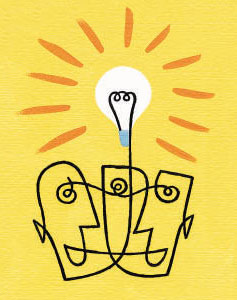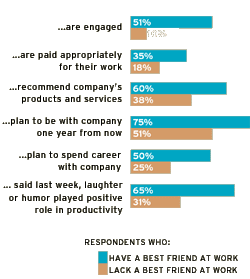If life imitated television, no manager in her right mind would want an employee to have a best friend at work. Think Lucy and Ethel in the chocolate factory or Ally and Billy at their law office.
 |
Of course everyone knows that television is not like life. Yet when it comes to friends in the workplace, many managers act as if TV is cinema vérité. "You frequently hear managers say they hire people to work, not to make friends," says Dana Baugh, a managing consultant with The Gallup Organization in Minneapolis. "The assumption is that workplace friendships aren't necessary and may even get in the way." But decades of Gallup research runs counter to that notion. In fact, Gallup has determined that having a best friend at work can turn a moderately engaged worker into a highly engaged one. The upgrade is significant because highly engaged workers contribute more to the bottom line.
The discovery of a quantifiable link between friendship and business results strongly suggests that fostering friendships should be a management priority. But the issue is also more nuanced than that. How does friendship correlate with better outcomes? What type of friendship most enhances a workplace? And are workplace friendships ever detrimental?
The most compelling data on work friendships comes from Gallup's Q12 workplace evaluations, which begin with a 12-question employee survey that measures how well workers' various needs are met. High survey scores indicate strong employee engagement.
"Do I have a best friend at work?" is one of the questions. (See "The Tenth Element of Great Managing" in the "See Also" area on this page.) Initially Gallup researchers were somewhat skeptical about the question's usefulness. But its statistical significance was undeniable. Namely, in hundreds of focus groups and thousands of employee interviews conducted when Gallup developed the Q12 survey, friendship trumped such seemingly obvious employee motivators as pay and benefits.
Once Q12 surveys are completed, Gallup consultants link the level of employee engagement to specific results, such as profitability, productivity, safety and customer loyalty. Result: An employer can see which strengths to emphasize and weaknesses to remedy to most improve workforce performance.
In the linkage stage of the Q12 process, Gallup has found that across companies, profitability and customer loyalty are "strongly associated with a high incidence of best friends in the workplace," says James K. Harter, a senior research director at The Gallup Organization who has led the Q12 linkage analysis. Best friendship also relates to productivity and safety, although the strength and consistency of the relationship varies from company to company.
|
|
 |
To be sure, friendship is not the only driver of engagement. Moreover, Gallup researchers purposely asked about a "best" friend, not simply a work buddy. Still, the nexus of workplace friendships, worker engagement and bottom-line results is clear. Consider:
When Q12 was administered to a random sample of U.S. workers 18 and older in late 2000 and early 2001, 51% of participants who strongly agreed with the statement "I have a best friend at work" were engaged, compared with only 10% of those who disagreed or strongly disagreed. Best friendship also translated into profit-enhancing behavior. For example, 75% of participants who had a best friend at work planned to be with the company for at least another year, vs. 51% who didn't have a best friend. In general, employees with best friends were more satisfied with their pay and benefits than those without, would recommend the company as a great place to work, and felt they were working to their full potential.
Other research sheds additional light on Gallup's findings. In 1997 Karen A. Jehn, professor of management at the Wharton Business School, told the Harvard Business Review that "although friends working together do socialize, their interaction greases the wheels for better work-related communication -- as long as they are dedicated to the task at hand or to the company's overarching goals." Jehn and Pri Pradhan Shah, an assistant professor at the Carlson School of Management in Minneapolis, devised an experiment in which 26 groups of three friends and 27 groups of three acquaintances were asked to follow specific instructions for building models made of Tinkertoys®. The friends built an average of nine models vs. 2.45 for the acquaintances. Friends "were able to challenge one another's ideas in a constructive way," says Jehn. "In the groups of acquaintances, people were almost too polite."
The good news for managers is that a dearth of workplace friendships is rather easy to fix. One example: When it turned out that hardly anyone had a best friend among a workgroup of engineers in a chemical manufacturing plant where Harter conducted a Q12 evaluation, the company initiated a coffee and doughnut social hour every morning. They also organized company outings. When the Q12 survey was repeated a year later, 60% of the workgroup strongly agreed with the "best friend" statement. Their overall level of engagement had also increased from the 53rd percentile of all workgroups that Gallup tracks to the 97th percentile.
Social activities aren't the only way to build friendships. On the recommendation of Gallup consultants, the supervisor at a manufacturing plant asked the participants at a morning meeting to tell the group something about themselves. Two managers who had been at odds learned that they were both war veterans -- he had been in Vietnam and the Persian Gulf; she had served in the Gulf. "That was the connection they needed to move beyond their surface impressions," says Baugh. Later, the supervisor reported that the two managers became much more efficient.
Fostering friendships can also be a pathway to achieving other management goals. Is your company trying to minimize errors? People who have a best friend at work are "more willing to ask that friend for help," says Baugh. Is your company trying to encourage individual initiative? "Friends are more willing to take risks because they feel they have people to support them," she says.
One caveat: Best friends are a great thing in a good workplace -- and a bad thing in a bad workplace. Take, for example, a workplace where employees describe the manager as "dictatorial," receive little recognition, and do not have a clear idea of what's expected. In that setting, best friends will spend time commiserating, which will exacerbate the counterproductive us-vs.-them tone of the workplace, says Baugh. But clearly, the management challenge in such instances is to improve overall conditions, not to discourage friendships.
The upshot: Good managers have nothing to lose and a lot to gain by encouraging best friends.